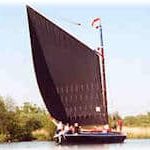
Canal and River Working Narrowboats and Barges
Canal boats, river barges and canal barges of England and the UK
One of the fascinations of the British inland waterways is the wide variety of boats and barges that populate them. Section written and illustrated by Tony Lewery.
Today the great majority are holiday cruisers custom-built for the purpose, but until the 1950’s the sight of a ‘pleasure boat’, as the working boatman would rather quaintly call it, was still unusual. Working boats were the norm, associated with the tiring stress of work rather than the pleasure of leisure, and most of the boat population were simply bemused by the idea that their commercial working waterways would ever become the preserve of a leisure boat business. But so it has become and although a small proportion of the old carrying boats survive as reminders of those utilitarian days, thousands more have rotted into the rushes leaving nothing but memories and faded photo.
Most of these survivors have been altered or converted to some degree, with extra cabins and home comforts to suit modern sensibilities, but a significant number have been preserved or restored to their original appearance by dedicated enthusiasts. A few even manage to earn a living delivering coal and fuel oil, and attempts are constantly being made to develop new traffics that will again prove the commercial sense of water-borne transport. But the twenty odd ton payload of a Midland canal boat is very small in modern terms, although the bigger barges on the Humber, Thames and Severn rivers might still provide the breakthrough that the waterways need, the renaissance of canal transport. In the meantime we can continue to admire the traditional skills of the boatbuilder in the examples that are left travelling the canals, preserved in museums or tucked away in odd corners of the waterway system.
The variety of styles and sizes of the old working boats is so diverse that the uninitiated visitor, however interested, can become quickly and understandably confused. The intention here is to offer a very general introduction to what is a complicated subject with some broad subdivisions that might help your understanding and enjoyment of our extraordinary waterway history.

Narrowboats
To conserve water canal locks were built just big enough to pass long thin 'narrowboats', ten times as long as they were wide, drawing about three feet.
Thomas Clayton’s operated a successful fleet of long distance wooden narrow boats especially equipped to carry liquid in bulk – tar, crude oil and creosote.
The horse drawn day boats or ‘joey-boats’ on the Black Country canals were vital to local industry, as were the BCN diesel tugs which later hauled them.
Prior to the nationalisation of the waterways in 1948 one of the largest canal carriers, and probably the most famous, was Fellows Morton and Clayton.

Barge & River Craft
The Leeds and Liverpool ‘short boats’, about sixty feet long and fourteen feet wide combining styles of construction from both east and west of the Pennines.
The characteristic carrying craft of the waterways linked to the Mersey estuary were the Mersey ‘Flats’, deep sided barges about seventy feet long by fourteen feet wide.
When the canals were in full commercial operation the canals had to be maintained to do their job and that required a supporting fleet of workboats.
The network of wide waterways in Yorkshire and most of the rivers running down to the Humber ports favoured massively built round bilged barges.

Sailing Craft
The River Severn down-river sailing barge, the Severn ‘Trow’ could trade from Gloucester and Bristol up to Stourport and Worcester, and out to South Wales.
The Thames sailing barge became the classic small working craft of all the rivers and creeks of the Thames estuary and the Essex coast. Also River Wey barges.
Norfolk Wherries, shallow-draft broad-beam barges with a two man crew, and a single mainsail were the indigenous trading craft of the Norfolk Broads.

Horse Drawn Boats
Horses are an important part of canal history, hauling boats into the middle of the 20th century, but their story gets overlooked in this mechanical age.
It needs two people to work a horse drawn boat, one to steer and keep the boat in deep water and the other to drive the horse. A third helper would be useful.
Working a horse drawn narrowboat required skills usually learned in childhood; handling the horse, starting and stopping the boat and passing other boats.

Boat Bibliography
Recommended reading about Canal and River Craft. Many may now be out of print but second hand copies are often available from specialist bookshops and online.
The painted decoration of working boats on the Leeds & Liverpool Canal, known locally as 'Brightwork', was one of the most colourful of Britain’s folk traditions.
All materials and images © Canal Junction Ltd. Dalton House, 35 Chester St, Wrexham LL13 8AH. No unauthorised reproduction.
About | Terms | Privacy| Refunds & Returns| Sitemap | Contact Us
With over 800 pages, this website uses cookies to record visitor behaviour using Google Analytics. More information on Privacy Page. Page last updated: 31/03/2025.